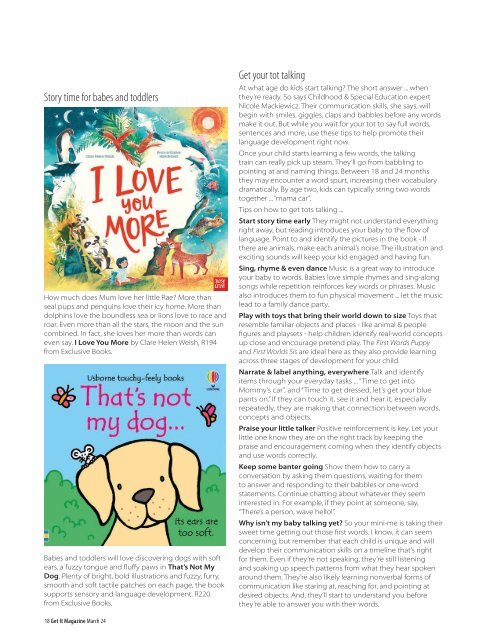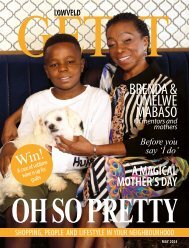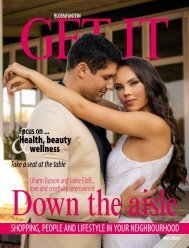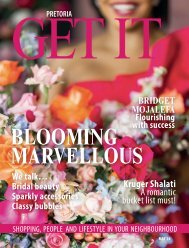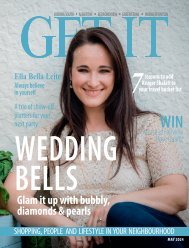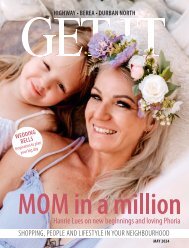Create successful ePaper yourself
Turn your PDF publications into a flip-book with our unique Google optimized e-Paper software.
Story time for babes and toddlers<br />
How much does Mum love her little Rae? More than<br />
seal pups and penguins love their icy home. More than<br />
dolphins love the boundless sea or lions love to race and<br />
roar. Even more than all the stars, the moon and the sun<br />
combined. In fact, she loves her more than words can<br />
even say. I Love You More by Clare Helen Welsh, R194<br />
from Exclusive Books.<br />
Babes and toddlers will love discovering dogs with soft<br />
ears, a fuzzy tongue and fluffy paws in That’s Not My<br />
Dog. Plenty of bright, bold illustrations and fuzzy, furry,<br />
smooth and soft tactile patches on each page, the book<br />
supports sensory and language development. R220<br />
from Exclusive Books.<br />
Get your tot talking<br />
At what age do kids start talking? The short answer ... when<br />
they’re ready. So says Childhood & Special Education expert<br />
Nicole Mackiewicz. Their communication skills, she says, will<br />
begin with smiles, giggles, claps and babbles before any words<br />
make it out. But while you wait for your tot to say full words,<br />
sentences and more, use these tips to help promote their<br />
language development right now.<br />
Once your child starts learning a few words, the talking<br />
train can really pick up steam. They’ll go from babbling to<br />
pointing at and naming things. Between 18 and <strong>24</strong> months<br />
they may encounter a word spurt, increasing their vocabulary<br />
dramatically. By age two, kids can typically string two words<br />
together ... “mama car”.<br />
Tips on how to get tots talking ...<br />
Start story time early They might not understand everything<br />
right away, but reading introduces your baby to the flow of<br />
language. Point to and identify the pictures in the book - If<br />
there are animals, make each animal’s noise. The illustration and<br />
exciting sounds will keep your kid engaged and having fun.<br />
Sing, rhyme & even dance Music is a great way to introduce<br />
your baby to words. Babies love simple rhymes and sing-along<br />
songs while repetition reinforces key words or phrases. Music<br />
also introduces them to fun physical movement ... let the music<br />
lead to a family dance party.<br />
Play with toys that bring their world down to size Toys that<br />
resemble familiar objects and places - like animal & people<br />
figures and playsets - help children identify real-world concepts<br />
up close and encourage pretend play. The First Words Puppy<br />
and First Worlds Sis are ideal here as they also provide learning<br />
across three stages of development for your child.<br />
Narrate & label anything, everywhere Talk and identify<br />
items through your everyday tasks ... “Time to get into<br />
Mommy’s car”, and “Time to get dressed, let’s get your blue<br />
pants on.” If they can touch it, see it and hear it, especially<br />
repeatedly, they are making that connection between words,<br />
concepts and objects.<br />
Praise your little talker Positive reinforcement is key. Let your<br />
little one know they are on the right track by keeping the<br />
praise and encouragement coming when they identify objects<br />
and use words correctly.<br />
Keep some banter going Show them how to carry a<br />
conversation by asking them questions, waiting for them<br />
to answer and responding to their babbles or one-word<br />
statements. Continue chatting about whatever they seem<br />
interested in. For example, if they point at someone, say,<br />
“There’s a person, wave hello!”.<br />
Why isn’t my baby talking yet? So your mini-me is taking their<br />
sweet time getting out those first words. I know, it can seem<br />
concerning, but remember that each child is unique and will<br />
develop their communication skills on a timeline that’s right<br />
for them. Even if they’re not speaking, they’re still listening<br />
and soaking up speech patterns from what they hear spoken<br />
around them. They’re also likely learning nonverbal forms of<br />
communication like staring at, reaching for, and pointing at<br />
desired objects. And, they’ll start to understand you before<br />
they’re able to answer you with their words.<br />
18 Get It Magazine <strong>March</strong> <strong>24</strong>


